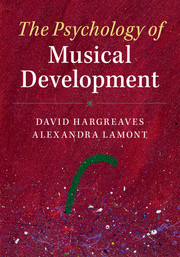Crossref Citations
This Book has been
cited by the following publications. This list is generated based on data provided by Crossref.
van Zyl, Silvia
2018.
Audiation, aural training and the visually impaired pianist in South Africa.
Journal of the Musical Arts in Africa,
Vol. 15,
Issue. 1-2,
p.
119.
Hargreaves, David J
and
Bonneville-Roussy, Arielle
2018.
What is ‘open-earedness’, and how can it be measured?.
Musicae Scientiae,
Vol. 22,
Issue. 2,
p.
161.
Zapata, Gloria P.
and
Hargreaves, David J.
2018.
The effects of musical activities on the self-esteem of displaced children in Colombia.
Psychology of Music,
Vol. 46,
Issue. 4,
p.
540.
Charisi, Vicky
S. Liem, Cynthia C.
and
Gomez, Emilia
2018.
Novelty-based cognitive processes in unstructured music-making settings in early childhood.
p.
218.
Groarke, Jenny M
2019.
Book review: Handbook of music, adolescents, and wellbeing.
Music & Science,
Vol. 2,
Issue. ,
Kondracka-Szala, Marta
and
Michalak, Marcin
2019.
Popular music in the educational space of Polish preschools – the teacher’s perspective.
International Journal of Music Education,
Vol. 37,
Issue. 1,
p.
22.
PAYNE, EMILY
2019.
Musicians in the Making: Pathways to Creative Performance edited by John Rink, Helena Gaunt, and Aaron Williamon, 2017. New York: Oxford University Press. 408 pp, Hbk, £53.00, ISBN: 9780199346677.
British Journal of Music Education,
Vol. 36,
Issue. 1,
p.
103.
Young, S.
and
Ilari, B.
2019.
Music in Early Childhood: Multi-disciplinary Perspectives and Inter-disciplinary Exchanges.
Vol. 27,
Issue. ,
p.
1.
Gembris, Heiner
Menze, Jonas
Heye, Andreas
and
Bullerjahn, Claudia
2020.
High-Performing Young Musicians’ Playing-Related Pain. Results of a Large-Scale Study.
Frontiers in Psychology,
Vol. 11,
Issue. ,
Bonneville-Roussy, Arielle
and
Vallerand, Robert J.
2020.
Passion at the heart of musicians’ well-being.
Psychology of Music,
Vol. 48,
Issue. 2,
p.
266.
Verneert, Filip
Nijs, Luc
and
De Baets, Thomas
2021.
A Space for Collaborative Creativity. How Collective Improvising Shapes ‘a Sense of Belonging’.
Frontiers in Psychology,
Vol. 12,
Issue. ,
Eisinger, Miriam
2021.
Struktur subjektiver Theorien über Musikalität und Validierung eines Messinstruments.
Jahrbuch Musikpsychologie,
Vol. 30,
Issue. ,
Peñalba, Alicia
Martínez-Álvarez, Lucio
and
Schiavio, Andrea
2021.
The Active Musical Room: Fostering Sensorimotor Discoveries and Musical Creativity in Toddlers.
Journal of Research in Music Education,
Vol. 69,
Issue. 2,
p.
128.
dos Santos, Regina Antunes Teixeira
and
dos Santos, Rafael Puchalski
2021.
Developing a Tool for Music Theory Placement: An Emphasis on Implicitly Learned Abilities.
Journal of Research in Music Education,
Vol. 69,
Issue. 1,
p.
43.
Woody, Robert H.
2021.
Psychology for Musicians.
Xu, Liuchang
Zheng, Ye
Xu, Dayu
and
Xu, Liang
2021.
Predicting the Preference for Sad Music: The Role of Gender, Personality, and Audio Features.
IEEE Access,
Vol. 9,
Issue. ,
p.
92952.
Prior, Helen M.
2022.
How Can Music Help Us to Address the Climate Crisis?.
Music & Science,
Vol. 5,
Issue. ,
Pausch, Viola
Müllensiefen, Daniel
and
Kopiez, Reinhard
2022.
Musikalischer g-Faktor oder multiple Faktoren? Struktur und Leistungskennwerte der musikalischen Hörfähigkeit von Jugendlichen.
Jahrbuch Musikpsychologie,
Vol. 30,
Issue. ,
Goopy, Jason
2022.
Children’s identity work in daily singing-based music classes: A case study of an Australian boys’ school.
Research Studies in Music Education,
Vol. 44,
Issue. 3,
p.
570.
McCullough, Lis
and
Finney, John
2022.
Living with the spiral: a duoethnographic perspective.
British Journal of Music Education,
Vol. 39,
Issue. 1,
p.
67.



